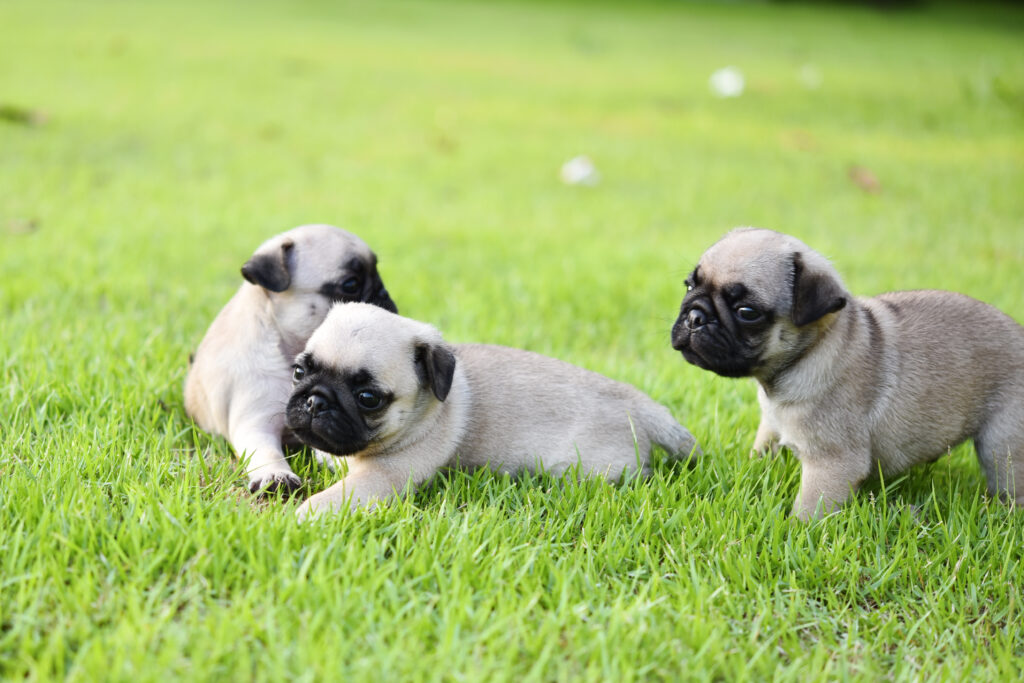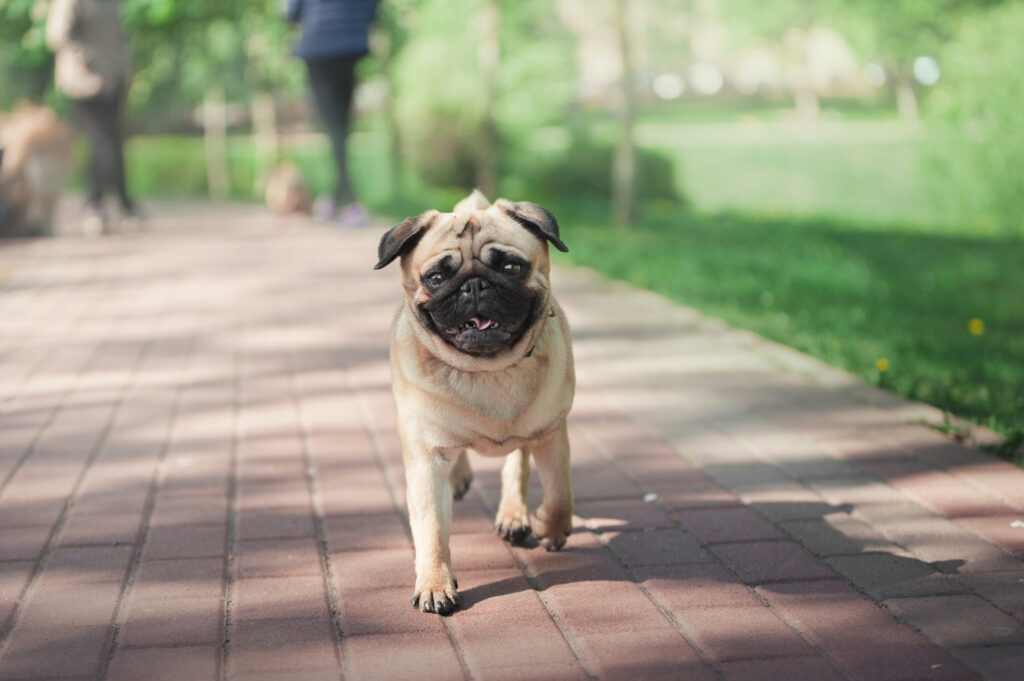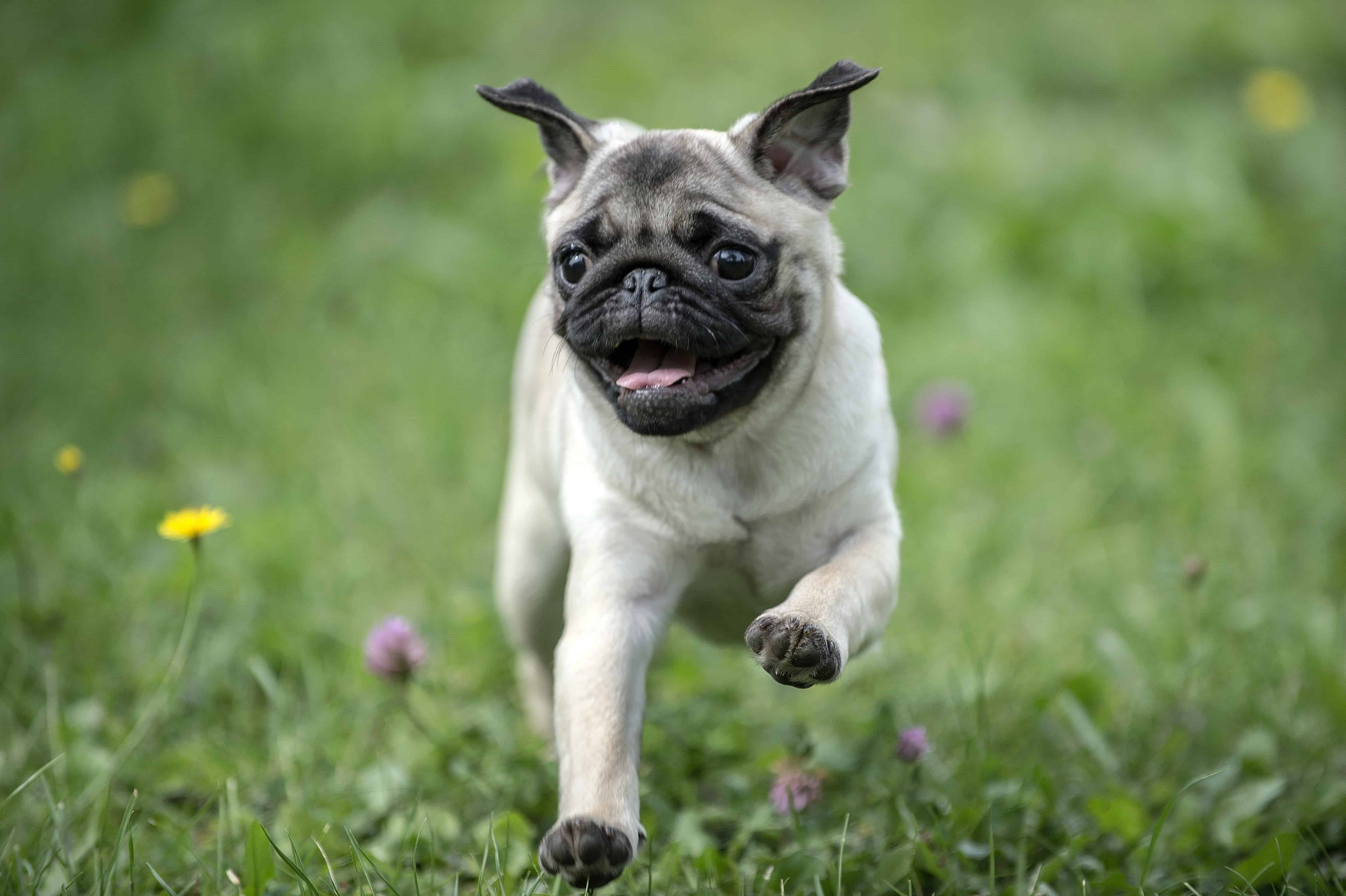With their bulgy eyes, curly tails, and squishy wrinkled faces, Pugs are easily recognized by dog lovers around the world. Deep-chested and muscular, Pugs are also the largest among toy breeds.
A flat-faced dog (brachycephalic) like the Bulldog, Pugs are prone to respiratory problems. They can turn into high maintenance dogs if the temperatures are high where you live. Pugs are unable to regulate their body temperature, so they are a poor choice for a pet if you live in a particularly warm climate.
In this article, we will give an overview of the breed, study their origins, and answer frequently asked questions.

Pug breed characteristics
The Pug is a small breed weighing between 14 and 18 pounds and 10 to 14 inches tall at their shoulder.
- Pugs love to be around other Pugs. Did you know that group of Pugs (at least three) is called a grumble?
- Even though they can’t be guard dogs, they are great watchdogs or alarm dogs. A Pug won’t hesitate to alert their owner if they see or hear something suspicious.
- Originally bred to be companion dogs in China for the ruling families, the wrinkles on the faces of Pugs mean Prince in Chinese.
- Pugs are very playful and thrive on attention. With enough care and attention, a Pug can form a strong relationship with their owner.
- Pugs are prone to major health problems such as Pug Dog Encephalitis, an inflammatory disease of the central nervous system which can be fatal, and other ailments such as patellar luxation, entropion, stenotic nares, and elongated palate.
History of the Pug
The Pug was bred to be a companion dog for the royal families in China. They were highly valued royal dogs who guarded alongside soldiers and lived in luxury. Pugs are believed to have first left China to Tibet, where Buddhist monks kept them in the monasteries as pets. The traders began importing Pugs to Europe from China in the 16th Century.
One of the most notable Pugs in history was named Pompey. He belonged to the House of Orange-Nassau, which ruled the Netherlands. Pompey alerted the Prince of Orange to the approach of assassins. Pugs became widely known after this event and eventually became popular in other European countries.

Pugs portrayed in Europe appeared to have longer legs and noses than today. It is believed that the modern look of the Pug emerged when a large number of Pugs were imported from China in the 1860s. The Pugs were coming directly from China and had shorter legs and flat-faces.
Pugs first arrived in the United States in the mid-19th century. The AKC recognized the breed in 1885, only one year after the organization was formed in 1884. The breed was initially very popular in the United States, but by the end of the century, their popularity declined. However, the Pug remains one of the most popular breeds in the world – ranking fifth in global popularity according to our 2019 analysis.
Modern day utilization of the Pug
Pugs are still companion dogs and they fulfill this role perfectly. They love attention and go along well with other animals and strangers. A Pug can be a good choice if you have cats – the AKC even recommends Pugs for cat owners who are thinking of adding a dog to their family.
Another reason that the Pug is a great choice for families is their calm temperament and affectionate nature, particularly around children. Pugs are a relatively tolerant breed, although a child should always approach the dog with respect.
The Pug is a quiet breed that won’t bark unnecessarily, and they adapt well to apartment living. About half an hour’s exercise goes a long way for Pugs and should be enough to keep them healthy and entertained for the day. This makes them the perfect breed for people who are too busy for most other breeds. Nevertheless, it is possible for Pugs to adapt to a more dynamic lifestyle. They love spending time and playing with their owners.
Combined with the fact that they are very easy-to-train, Pugs can be a great pet for everyone. As long as you have enough time and attention to offer them, they will make a great companion dog.

Frequently Asked Questions About Pugs
What is the lifespan of a Pug?
The average lifespan of a Pug is between 12 and 15 years. Pugs are relatively low maintenance dogs. However, they need regular exercise, a proper diet, check-ups, and appropriate socializing just like any other breed. A well taken care of Pug will live longer and common health problems seen in the breed such as respiratory diseases are less likely to emerge.
How much exercise does a Pug need?
Pugs can rely on very little exercise. Even 20 minutes of exercise is enough for most Pugs. It’s important to take them out on walks in the morning or late in the day, as they don’t perform well in the heat and can struggle with breathing. A normal body temperature for a Pug is between 101 and 104 degrees. A body temperature above 105 degrees – and especially above 108 degrees – can lead to health risks which can be fatal.
How fast can a Pug run?
Pugs have remarkably strong legs and they love running, even if they aren’t the quickest – on average, Pugs can run as fast as ten miles per hour. It’s okay for a Pug to jog or run short distances, but their lack of stamina means they struggle with longer distances. They need plenty of physical exercise to get into shape before they can cover longer distances.
How do you cut a Pug's nails?
Cut the nails of your Pug using a dog nail clipper. Do not use human nail clippers, as this can lead to injuring your dog. Be sure that you and your Pug are in a well-lit room before getting started. Start cutting your Pug’s nails by separating the toes using your fingers, but don’t squeeze as this can hurt and irritate the dog. Keep the clippers parallel to the Pug’s nail and make sure not to cut it across the finger. After cutting the nails, you can also trim any excess toe hair.
How often should you bathe a Pug?
Pugs don’t need baths often. Contrary to conventional wisdom, they shed. Brush your Pug every once in a while to remove dead hair and distribute natural oils for a healthier coat. If your Pug gets dirty, bathe by using hypoallergenic pet shampoo and warm water. Rinse with warm water thoroughly to get rid of any shampoo residue. It’s important to dry their coat quickly because Pugs don’t tolerate temperature changes well and it can lead to them catching a cold.
How much should you feed a Pug?
Pugs have a big appetite for a small breed. They can become obese if their diet isn’t monitored. An adult Pug should be fed with a 1/2 cup of dog food, one to two times a day depending on the activity level. Puppies need to be fed at least four times a day – each meal consisting of a 1/4 to 1/2 cup of puppy food.
Read more in this series:
- About The Breed: Basset Hound
- About The Breed: Beagle
- About The Breed: Bloodhound
- About The Breed: Bulldog
- About The Breed: Chihuahua
- About The Breed: Dachshund
- About The Breed: German Shepherd
- About The Breed: Greyhound
- About The Breed: Golden Retriever
- About The Breed: Labrador Retriever
- About The Breed: Pembroke Welsh Corgi
- About The Breed: Pomeranian
- About The Breed: Siberian Husky


You must be logged in to post a comment.